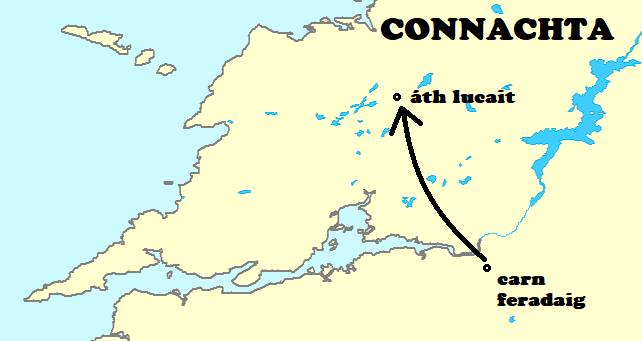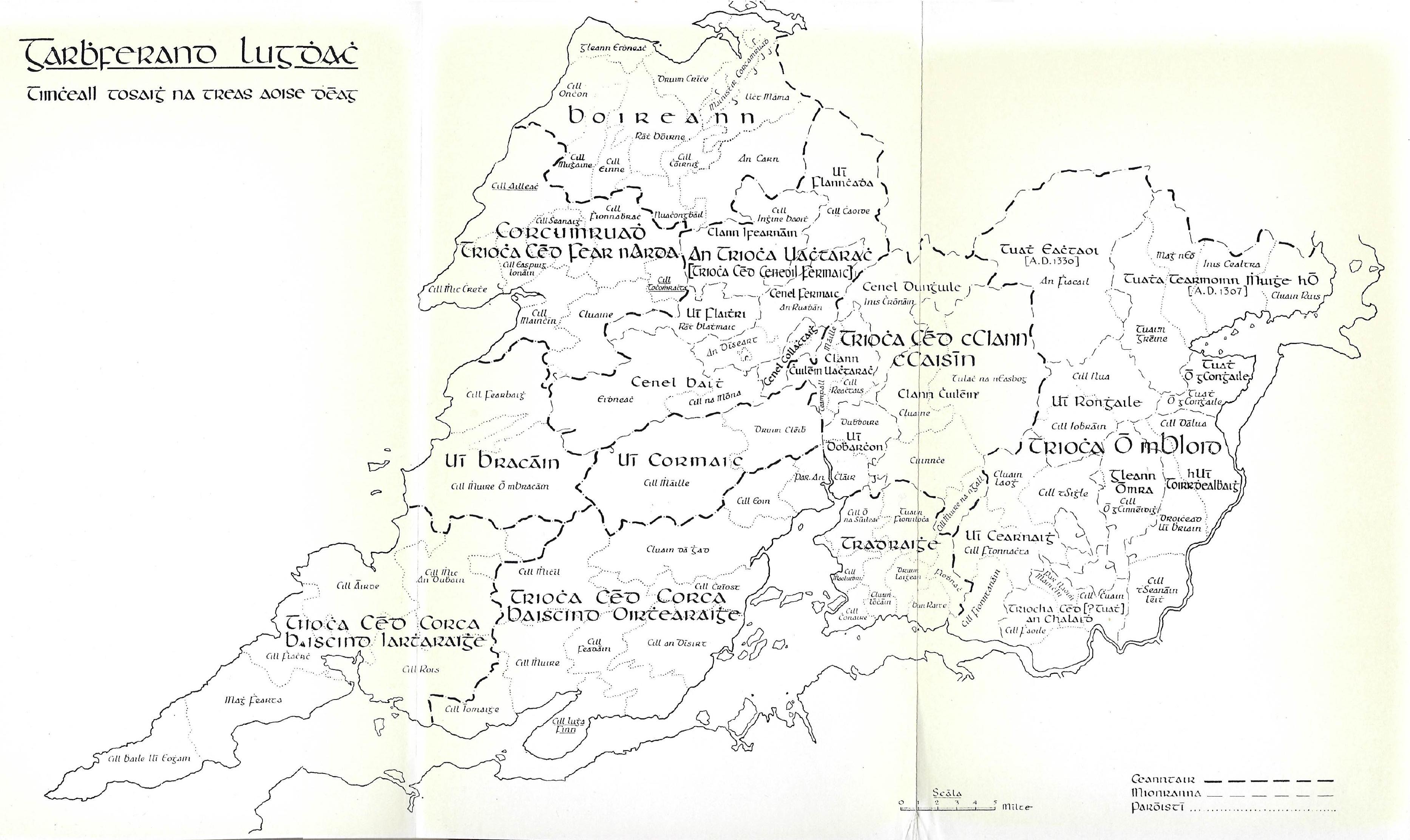Aonghus Tíreach (The Landed) (d. 383AD)
Had issue:* Lugaid MendAlso had issue three other sons, who were ancestors of the Déisi Bécc and the Southern Déisi and Déis Beag (interchangeable):* Eoghan* Dubh Rois - Descended from him there were (uí Rosa) fourteen kings who ruled the Déisi Bécc and fifty saints and other clergy – including one who dwelt at Saingil.* Seasgaidh According to other genealogies the aforementioned Déisies stem from Lugaid and not his brothers. (Jaski 2014) (ALM page 294) (Story of an Irish Sept... page 67)Lugaid Lámderg (Red Hand)
Also called Lugaid menn (illustrious). the Cogadh Gaedhil re Gallaib uses Clann Lugaid or Síl Lugaid as an alternative term for Dál Cais, and particularly for the Northern Déisi. Flann states that the warrior Finn (mac Cumaill) already prophesized the strength of the youth (nert na n-óc) from the south, and that although the plunder was with the Connachta, the Munstermen would enjoy it.(Jaski 2014) According to tradition he drove the Fir Bolgs out of Thomond and annexed it to Munster. “ He it was that first and violently grasped the land of Tuadh-Mumha [i.e. the modern county of Clare]—for which reason it is called Lugaid Red-hand’s rough sword-land (Gairbfherand claidim Luigdech Laimdeirg), seeing that the countries which the men of Mumha acquired by main force were two, viz., Osraighe in eric for Edirsceol whom the men of Laigen slew, and Tuadh-Mumha in eric for Crimthann, son of Fidach. Howbeit .... according to the legal right of the [old] provincial partition Tuadh-Mumha belongs to the province of Connachta.”*Now the ostensible reason why Lugaid seized on the land beyond the Sinainn as eric for Crimthann was this :—
Crimthann the Great, of the Eoganachta race, brother-in law of Eochaid Muigmedon, to whom he succeeded in the sovranty of Eire (365) had for sister Mongfionn the Queen, and her vehement desire was that her favourite son Brian should be Ard-ri after Crimthann her brother. To compass her purpose, and to that end, she entertained her brother while on a visit to the province of Connachta, at a banquet, whereat she handed him a poisoned cup of wine:
‘ Received he drink of poison in his house From his sister, from the daughter of Fidach.’
“ I will not drink,” said he, “ until thou first shalt have drunk.” She drank accordingly and Crimthann after her. Mongfionn died on Samhain’s Eve . . . but Crimthann from the north, progressing towards his own country, gained Sliabh-suidhe-in-rig (the mountain of the King’s sitting) near Creatalach beyond the Sinainn, and there he died (A.D. 379).
. . . Howbeit Mongfionn’s treachery and her choice of death for herself, served her purpose not at all, for Niall of the Nine Hostages succeeded Crimthann, and ruled all Eire (379-405).+
 Lugaid gained seven battles over the Connachta, killed seven kings, and drove them with
only hirelings and boys from Carn Feradaig to Áth Lucait. He guarded his newly acquired territory so well ‘ that not even a leveret escaped northward.’ Thus he made good his claims, and thus was that land annexed to Leth-Mogha, to which half of Eire it nominally had belonged, lying as it did southward of the frontier set up by Conn and Eoghan: but it was not entirely subdued till about the beginning of the fifth century, for Connachta’s kings made many attempts to recover possession of it.
Lugaid gained seven battles over the Connachta, killed seven kings, and drove them with
only hirelings and boys from Carn Feradaig to Áth Lucait. He guarded his newly acquired territory so well ‘ that not even a leveret escaped northward.’ Thus he made good his claims, and thus was that land annexed to Leth-Mogha, to which half of Eire it nominally had belonged, lying as it did southward of the frontier set up by Conn and Eoghan: but it was not entirely subdued till about the beginning of the fifth century, for Connachta’s kings made many attempts to recover possession of it.
The kingdom of Tuath-Mumha after this conquest extended from the isles of Aran and Sliabh Echtghe on the north to Sliabh Eibhline near Caisel; and from the cliffs of Leim-Conchullainn, eastward to Sliabh-Dala in Osraighe. “ And the Dal-gCais had it free without rent, without taxing from the Kings of Eire.”*
When Lugaid attained in due course the Kingship of Mumha, he invaded Wales and exacted its tribute, and sailing northward carried his forays into Alba, where he was likewise victorious. (Twigge) (ALM, pg. 78-81 [Gaelic text is similar to Twigge's narrative] ) Two sons (ALM page 294):* Conall Eachluath* Loisceann - From which descend the Í Loiscinn Loimthighe
Conall Eachluath (of the swift steeds) (359-434)
He was fostered as a boy to the High King Crimthann mac Fidaig in 366. He became close friends with his foster father who lobbied to ensure his future election as King of Munster. This was displeasing to the Eoganacht who wanted Conall Corc to succeed. He met with them and they agreed to follow the rule established by Oillion Olum whereby the two families would alternately succeed, he allowed Conall Corc to succeed under the condition that he would succeed him on his death. He was given hostages to enforce this agreement. On Conall Corc's death he succeeded him peacefully. During his reign the Connachta made strenuous attempts to regain the territory conquered by his father Lugaid, and his eldest son and heir Enna was constrained to effect a compromise with the race of Eoghan for the succession of the kingship of Munster.(Twigge) He had two sons:* Enna Airctheach (the plunderer) - Succeeded his father. (ALM page 84) (Story of an Irish Sept... page 66/67 [Source of birth/death dates. Contradicts that Énna succeeded Conall, but probably a mistake.]). From him descend uí énna and the uí Erc in osraige. (ALM page 294)* Tál Cas - succeeded on the latter's death.Tál Cas (b.c 400AD)
 Iron Age Déis Becc Chieftain. Son of Conall Eachluath and Coirpthe, daughter of High King Eochaid Mugmedon. He was the King of Thomond, he made a gavel of his territory and divided it between his four eldest sons. He was called Tál (adze) as he was the foster son of a wright. On his death he passed the kingship to his eldest son Blait. (Twigge) He was the eponymous ancestor of all the Dál gCais (earlier called In Déis Tuaiscirt or Northern Déisi). He evidently possessed the Y SNP mutation R-Z17669 as this is the common ancestor of lines of documented Uí Bloid, Uí Caisín and Cineal Fearmaic descended septs, whom he is ancestor to through three of his sons. He had issue thirteen sons(ALM page 294/295, page 237):* Bloid (the eldest) (a quo the Ui Bloid)*Caisín (died 461) (a quo Uí Caisín)* Aonghus Ceann Nathrach (Snake Head) (a quo Cineal Fearmaic, Cineal Collachtach, Cineal Baoith)* Aonghus Ceann Aitinn - from whom descend Clann Ifearnain (from whom descend Ó Cuinn)(ALM page 245)(ALM page 316), Clann Neachtain and "an Inghean Bhuidhe gona mac Oilill".
* Lughaidh Dealbhaoth (fire producer) - He was a druid. From him descends the five Delbna and also Muinnter Chochláin (Mag Cochláin) and Mac ConRaoi (ALM pg. 244/255).
He had a daughter named Aoife who married the druid/chief Trad. Aoife and Trad banish Lughaidh and the land they occupy becomes Tradraige (after being banished he used his powers to light a fire, producing five streams of flame which he commanded his five elder sons to follow, this is how the Delbna became scattered).(Story of an Irish Sept... page 84)Delbáeth, he is the second Lugaid from whom are the five Delbna
wherever they are. the two énnae, i.e. énna Téith
and énna Airgdech; the two Gnó, i.e. Gnó Mór and Gnó Becc; and
Dáelbaeth’s other son was Dési whose sons were Becc, Erc, Mac Reithi.
énna Téith in the land of the Southern Déisi (énna Airgdech in the land
of the Northern Déisi).
Five sons of énna Airgdech, i.e. Conchrad, Dáire Tuidlech, Cormac,
Condla, Cairpre.(Book of Lecan, Jaski 2014)(There is clear confusion and/or duplication here between the Énna Airctheach mentioned as the son of Lugaid Dealbhaoth the son of Cas and the Énna Airctheach who is the son of Lugaid Lámderg)
* Carthan - From him descends the Dal gCais Leithe Lachtmhuighe.
Iron Age Déis Becc Chieftain. Son of Conall Eachluath and Coirpthe, daughter of High King Eochaid Mugmedon. He was the King of Thomond, he made a gavel of his territory and divided it between his four eldest sons. He was called Tál (adze) as he was the foster son of a wright. On his death he passed the kingship to his eldest son Blait. (Twigge) He was the eponymous ancestor of all the Dál gCais (earlier called In Déis Tuaiscirt or Northern Déisi). He evidently possessed the Y SNP mutation R-Z17669 as this is the common ancestor of lines of documented Uí Bloid, Uí Caisín and Cineal Fearmaic descended septs, whom he is ancestor to through three of his sons. He had issue thirteen sons(ALM page 294/295, page 237):* Bloid (the eldest) (a quo the Ui Bloid)*Caisín (died 461) (a quo Uí Caisín)* Aonghus Ceann Nathrach (Snake Head) (a quo Cineal Fearmaic, Cineal Collachtach, Cineal Baoith)* Aonghus Ceann Aitinn - from whom descend Clann Ifearnain (from whom descend Ó Cuinn)(ALM page 245)(ALM page 316), Clann Neachtain and "an Inghean Bhuidhe gona mac Oilill".
* Lughaidh Dealbhaoth (fire producer) - He was a druid. From him descends the five Delbna and also Muinnter Chochláin (Mag Cochláin) and Mac ConRaoi (ALM pg. 244/255).
He had a daughter named Aoife who married the druid/chief Trad. Aoife and Trad banish Lughaidh and the land they occupy becomes Tradraige (after being banished he used his powers to light a fire, producing five streams of flame which he commanded his five elder sons to follow, this is how the Delbna became scattered).(Story of an Irish Sept... page 84)Delbáeth, he is the second Lugaid from whom are the five Delbna
wherever they are. the two énnae, i.e. énna Téith
and énna Airgdech; the two Gnó, i.e. Gnó Mór and Gnó Becc; and
Dáelbaeth’s other son was Dési whose sons were Becc, Erc, Mac Reithi.
énna Téith in the land of the Southern Déisi (énna Airgdech in the land
of the Northern Déisi).
Five sons of énna Airgdech, i.e. Conchrad, Dáire Tuidlech, Cormac,
Condla, Cairpre.(Book of Lecan, Jaski 2014)(There is clear confusion and/or duplication here between the Énna Airctheach mentioned as the son of Lugaid Dealbhaoth the son of Cas and the Énna Airctheach who is the son of Lugaid Lámderg)
* Carthan - From him descends the Dal gCais Leithe Lachtmhuighe.* Aedh - From him descends the Uí Aedha* Lughaidh Éile - From him descends the Uí Mhaoil Bhaodáin, Muinnter Dhobharchon, Muinnter Chonraoi, Muinnter Chearnaigh, Muinnter Aonghusa, Muinnter Dhubhthaigh* Séadna - From whom descends Mainchín Luimnigh and "na hingheana filet i gCill na nlnghean"* Cormac - No descendents* Caindeach - From whom descends "Epscob Mac Láire Tinn"* Nae - From whom descends "Beag Mac Dé"* Loisceann - No descendents

